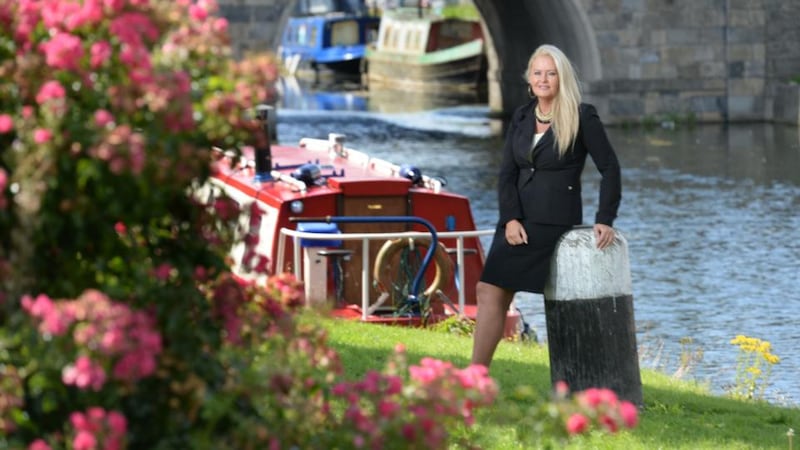On the face of it, Boyle, in Co Roscommon and Sallins, in Co Kildare, are quite alike. They are two small Irish towns. Both sit on waterways, and both have train stations. But that’s where the similarities end. Why? Sallins is within commuting distance of Dublin. Boyle is not.
Boyle was hit hard by the recession. The Royal Hotel, once the hub of the town, closed a few years ago, and it’s becoming an eyesore as it deteriorates. Some of its window panes are broken, and the “O” is missing from its name. Sprigs of greenery sprout from the windows and balcony.
The hotel was one of Ireland’s earliest architect-designed hotels. It was built in 1782 and was a staging post for Bianconi’s horse-drawn coaches.

Farther down the street McDonagh’s newsagent, once a popular stopping-off point for people passing through the town, has also closed. Across the road, the National Irish Bank is gone.
Alison Clarke of Clarke’s Bar and Restaurant says it feels as if the town has been forgotten. “It’s a struggling town because we are a satellite town for Sligo, Roscommon and Carrick-on-Shannon,” she says. Boyle attracts many tourists during the summer because of Lough Key Forest Park, which is on its doorstep, and historical attractions such as Boyle Abbey, but things get very quiet when the holiday season ends. Most people travel from Boyle to work in those larger towns. “People in Roscommon town, never mind Dublin, don’t realise what 20 jobs would do for Boyle,” Clarke says.
Adding to their woes is having to boil all their water before they can drink it, because of cryptosporidium. The problems began more than a year ago. Clarke has installed a purification system to make the water safe. “It cost money, yes, but I was finding that people were resentful of the fact that I couldn’t give them a glass of water. Now I have peace of mind preparing and serving food.”
She says this would never have been allowed to continue for so long in Dublin. “Boyle is a forgotten town. Remember the hoo-ha in Dublin when they had to turn off the water for a few hours? We have this issue going on for how long? And now they intend to start charging us for water we can’t even drink. It’s ridiculous. We are just walked upon. People say, why don’t we shout a bit louder, but nobody wants to listen to people in a small town. We’re just completely forgotten about.”
The median asking price of a three- or four-bedroom house in Boyle was €300,000 in 2007, according to Myhome.ie. Today it is just over €109,000.
Cross the country to Sallins and the asking price was €360,000 in 2007. Today it is €205,000.
Things are looking up in the Co Kildare town, according to Sharon Nolan of Nolan Properties. The estate agent, who is based in the centre of Sallins, says she has seen the mood lift since 2013. “Definitely in the last year things have started to move, but particularly since May,” she says. “June just skyrocketed for some reason. For instance, a two-bed apartment in Sallins, Naas or Clane, we would have been hard pushed to get €70,000 or €80,000 for it. Now they are achieving €115,000 or €120,000.”
Nolan says all that kept estate agents going during the recession was property rental. “There were hardly any viewings or sales at all. Definitely we’ve turned a corner now. We can see a lot of foreign nationals beginning to buy houses: Polish and Lithuanians. They are looking for starter homes. And you have a lot of investors starting to buy again.”
A few new shops and small businesses have opened in the town in recent times, and the Sallins Business Association is encouraging businesses to work together.
Mirror opposites
Trutz Haase, a social and economic consultant, says Sallins and Boyle are almost mirror opposites when it comes to measuring affluence and deprivation. Haase and a fellow economist, Dr Jonathan Pratschke, devised a deprivation index that shows the affluence or deprivation of thousands of areas around the country.
It shows that the counties most affected by the economic decline were outside the Dublin region. The index uses a scale that takes into account issues such as education levels, age dependency – the number of dependent people, which is to say younger than 15 or older than 64, relative to the working-age population – number of lone-parent households and the ratio of semiskilled and unskilled workers.
The index goes from -30 to +30; the average deprivation score is zero. Sallins score 9.3. Boyle score -11.3.
Haase highlights the population change in the two towns between 2006 and 2011. “Sallins had a growth of 30 per cent – one of the fastest-growing areas. Boyle had a 9.4 per cent population loss at a time when Ireland gained 8 per cent. So that’s a massive outward migration.”
Boyle’s percentage of lone parents stood at 31.6 per cent in 2011, compared with 9.9 per cent in Sallins. “Particularly for a rural town, that is an extraordinarily high lone-parent ratio,” he says. The State average was 21.6 at the time.
The percentage of local-authority houses was just 1.1 per cent in Sallins but 20.2 per cent in Boyle.
In 2011, 21.8 per cent of people in Boyle had finished their education at primary level, compared with just over 6 per cent in Sallins. “That’s again the effect of emigration. You have elderly people who left school early who are staying in the area; it’s the young educated people who are leaving.”
In contrast, 43 per cent of people in Sallins had third-level education. Boyle recorded 18 per cent.
“They are both rural towns, but Sallins is within the wider commuter belt of Dublin,” Haase says. “Once you are within the commuting distance of a major city or town, then, if you live in a rural area, your offspring can find employment, urban-based, and maintain a rural lifestyle.
“But when you go to Roscommon or Leitrim you are out of that commuting distance, and you are beyond where you can access major labour markets.” And that’s when rural starts turning into decline.
“There’s no automatic thing that rural areas are more or less deprived,” Haase says. “The key thing is proximity to urban labour markets. These towns’ trajectories are going in opposing directions due to their connectivity to urban labour markets.”
But it's not all bleak for Boyle. The local actor Chris O'Dowd, star of The IT Crowd and Bridesmaids, has brought some fame to the town by using it as a backdrop in his Moone Boy series.
A few food businesses have opened in recent months, and a shuttle bus recently began to operate between Lough Key Forest Park and Boyle, to encourage tourists and holidaymakers to come into the town.
Clarke says Boyle has a lot going for it and still has a superb reputation for clothes shops for women. “I travelled the country looking for dresses before I got married, and I came home and bought everything in Boyle,” she says.
There are also hopes that a closed fish factory will soon reopen. “We are clinging on to hope,” Clarke says. “We are waiting and waiting for this announcement. We have to keep positive.”











